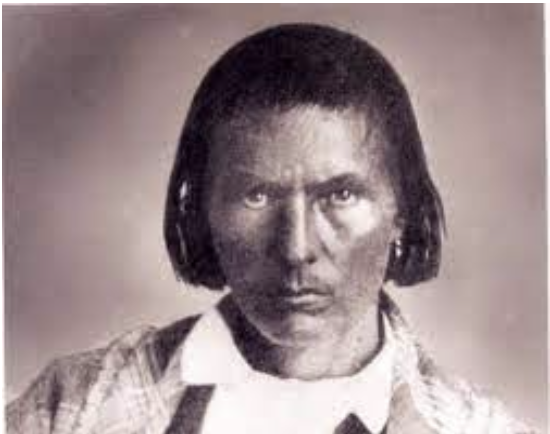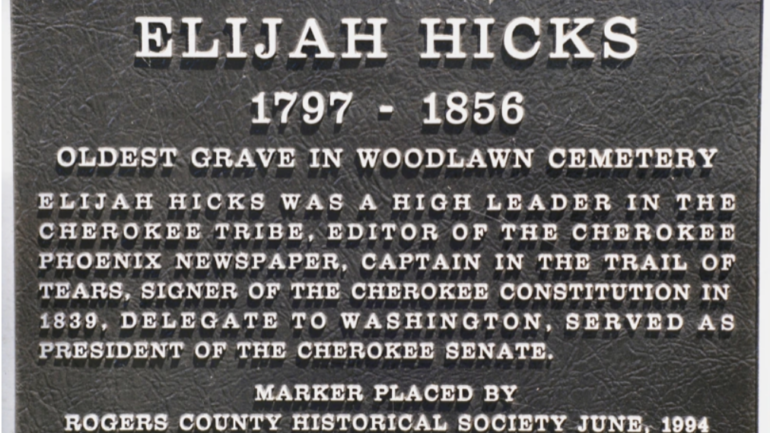Telling the history of Claremore…one story at a time.
Published in the May 1957 Ranchman Magazine, by Myron A. Hurd.
Bluford Starr – Pioneer of Claremore, Part One
Bluford Starr was one of the outstanding pioneer cowmen in the vicinity of Claremore and Inola for 40 years or more, and some of his oldtime cowboy friends have nominated him for the Cowboy Hall of Fame at Oklahoma City. Whether or not his friends achieved this honor to his memory, no one can say that he did not attain outstanding success in spite of his handicap of being an orphan boy, and being able to get barely enough education to enable him to read and write. Blue West Starr was born at Fort Gibson, Indian Territory, September 1, 1858, a few months after his father, Bluford 1st, had died, and his mother passed away two years after his birth. Aunt Nancy Jane Chambers took him to raise at Fort Gibson. The Civil War began the next year and the Chambers family and their friends fled to Texas for the duration. After the war, about 1866, the Chambers, along with 16 other families, returned to Cherokee Nation. They all settled near the Big Lake and Verdigris River south of Claremore, where Uncle Joe Chambers started his store and post office known as Ponlas. On the return trip from Texas, Blue Starr, a boy of 8, helped drive the huge drove of hogs which the families had accumulated while in Texas. Blue Starr’s meager schooling began at Westpoint (two miles southeast of Claremore) in 1869 at the age of 11. He attended one short term. Blue was sent to the Cherokee Orphanage at Salina for a term or two of schooling, but when smallpox broke out, he became scared and walked off from the school, not stopping until he arrived at the Chambers home at Ponlas. His education thus completed, he went to work for Doc Denny, a ranchman near Verdigris Switch. One of Blue’s jobs at the age of about 14 was to help drive a drove of hogs from Muskogee to Parsons, Kansas market, where he saw his first steam engine and train. He said he had never seen anything larger than a hay stack before and it was frightening to hear this engine puff and snort and spout steam. In 1874, when Blue was 16 years old, he went to Choteau to boil water at a salt well to secure a salt supply for the Chambers family. The Katy Railroad was being built at the time and he hung around for awhile to watch the marvels of railroad construction. During the next few years, Blue Starr had many and varied experiences. He helped Doc Denny trail herd cattle up the Texas Trail. He rode the Pony Express from Ft. Spunky to Chetopa, Kansas and carried the mail. When the Frisco began the survey of the right of way from Vinita to Red Fork, he drove the team and wagon which hauled the survey crew and their instruments. After the Frisco was completed, he hauled freight from Pryor Creek to Claremore and from Chouteau to Catoosa and Tulsay Town. In fact, he saw Tulsa when it was only a camp, and a Creek Indian family by the name of Childers ran a boarding house, and Jim Hall had the first store. When the first Frisco train ran through Claremore in 1882, a big celebration was held. Preacher Allen of the Presbyterian Church made the talk and as soon as he had finished, Blue and other cowboys pulled out their pistols and emptied them into the air. Once when Starr was driving a freight wagon with a four-up team and a saddle horse tied behind, they camped in the Verdigris River bottoms. The next morning, Starr got on the saddle horse to round up the hobbled mules and horses and found that they had strayed a long ways from camp. While searching for them, he came upon a campfire which was still burning and a dead man beside it with a bullet through his head. When Starr returned to camp and reported finding a dead man, he and the boss agreed to tell no one for it would mean a long trek to Judge Parker’s court in Ft. Smith to appear as witnesses, and a lot of lost time. They knew that someone else would find the man and report it. Blue Starr went to work for C. W. Turner, owner of the Three Bar ranch north of Inola. Turner was a wealthy man who owned a hardware store in Muskogee. The ranch was bounded on the east by the Katy Railroad, on the south by the Creek Nation, on the north by a drift fence built east from the Verdigris River about two miles south of Tiawah, and on the west by the Iron Mountain Railroad after it went through in 1889. Orange Fuller of Wagoner was foreman of the ranch. Blue Starr met his wife, Marion Jesse Adell Hutchins at a dance at Fort Gibson. Born at Madison, Wisconsin, August 29, 1865, she was 12 years old when she arrived at Ft. Gibson with her father, who was in charge of construction of the Katy Railroad. Later when Blue saw her at the dance, he was wearing a Mexican sombrero and smoking a cigar and she would not meet him. Blue’s daughter, Marion Starr Mumford, says they have a letter mailed later at Chouteau in which their father wrote their mother expressing his pride in meeting her and asking her permission to correspond with her. Blue and Adell Hutchins were married at Fort Gibson by the clerk of the Cherokee court. The ceremony took place in the Dan Young home. Twenty-five years later, and after all of the children were born, the Starrs were notified that they were not legally married and that they should have another ceremony performed. But Blue said to h—with them…that he felt sufficiently married. After the wedding, Blue and his young bride moved on a farm on Dry Branch Creek near Fort Gibson where he farmed for two years. It was here that Charles C . was born October 1, 1888. Blue nearly worked himself to death but raised a big corn crop. Then a storm came up and lightning struck the barn and burned it, his cribs and all of the corn. The Blue Starrs returned to Inola when Charles was 6 months old and took charge of the Three Bar ranch…Blue as foreman and his wife as cook. Then when Charles was two years old, the family returned to Fort Gibson for the birth of the second child, Dr. Orange Walter Starr, April 22, 1890. Mrs. Starr’s full-blood Cherokee stepmother served as midwife.Then when Orange was 12 days old, his mother rode side saddle to Fort Gibson with him on her lap, and rode the caboose of a freight train back to Inola and home on the ranch. Dr. Orange says his mother was a strong, healthy pioneer woman who could get up a dinner for 25 cowboys on a 30 minute notice. When Glenn Starr was born July 6, 1893, Dr. A. J. Lane, father of Gazelle Lane of Claremore, drove 25 miles from his home at Oowala for the delivery. Jessie Marion, the youngest child was born December 24, 1894 and Dr. Lynn of Claremore was called the 12 miles for the delivery. The Starrs say that Marion did not cost their father anything, as he won the fee, which was usually about $15.00 for delivering a baby, from Dr. Lynn on a matched horse race. Blue Starr loved fine horses and always rode and drove the best. You will want to read about some of their horses, life at the Three Bar Ranch, or their old ranch on Sealy Bark Mountain, and the three-story house they built in Claremore in Part Two of Bluford Starr – A Pioneer of Claremore.




